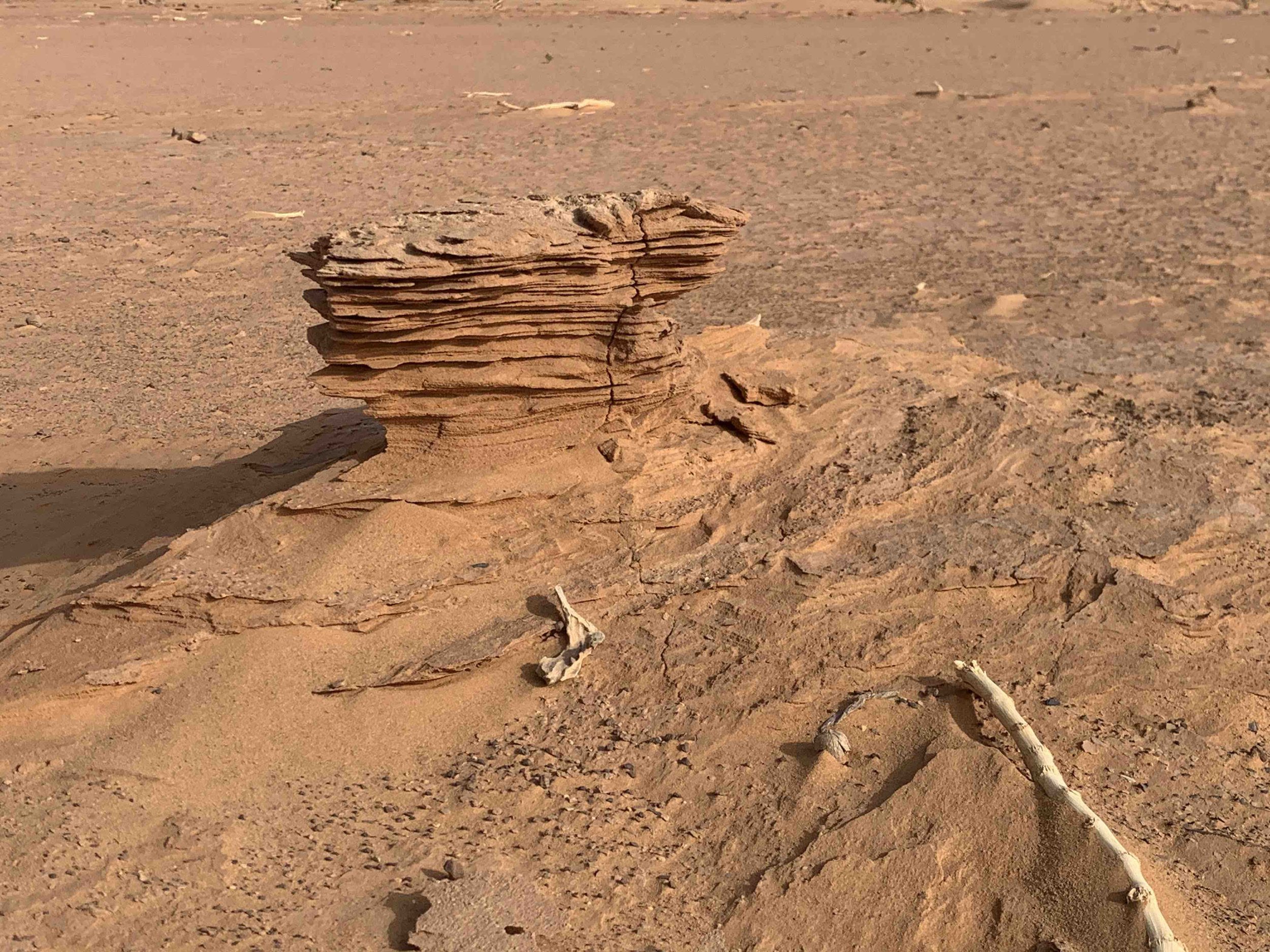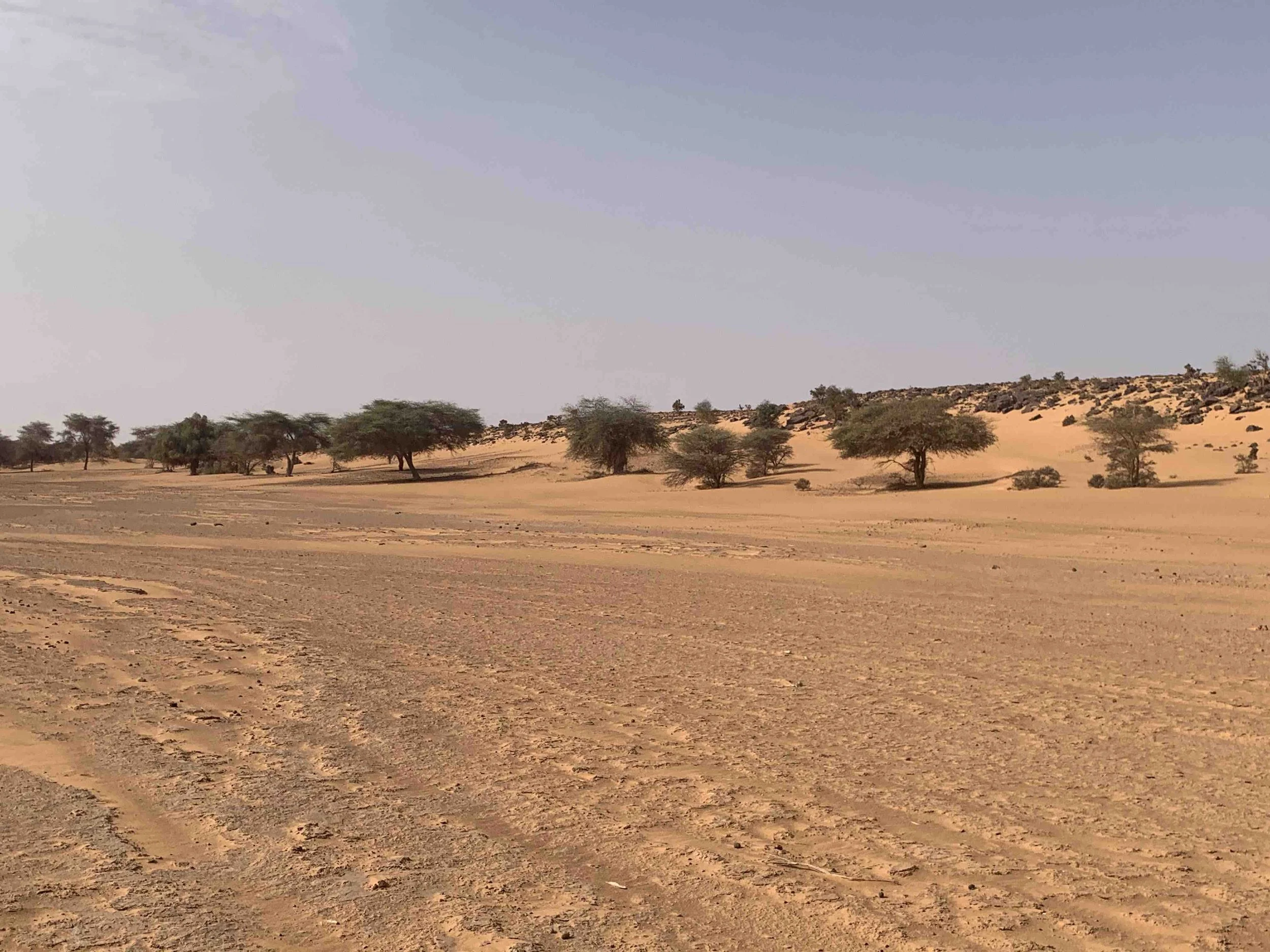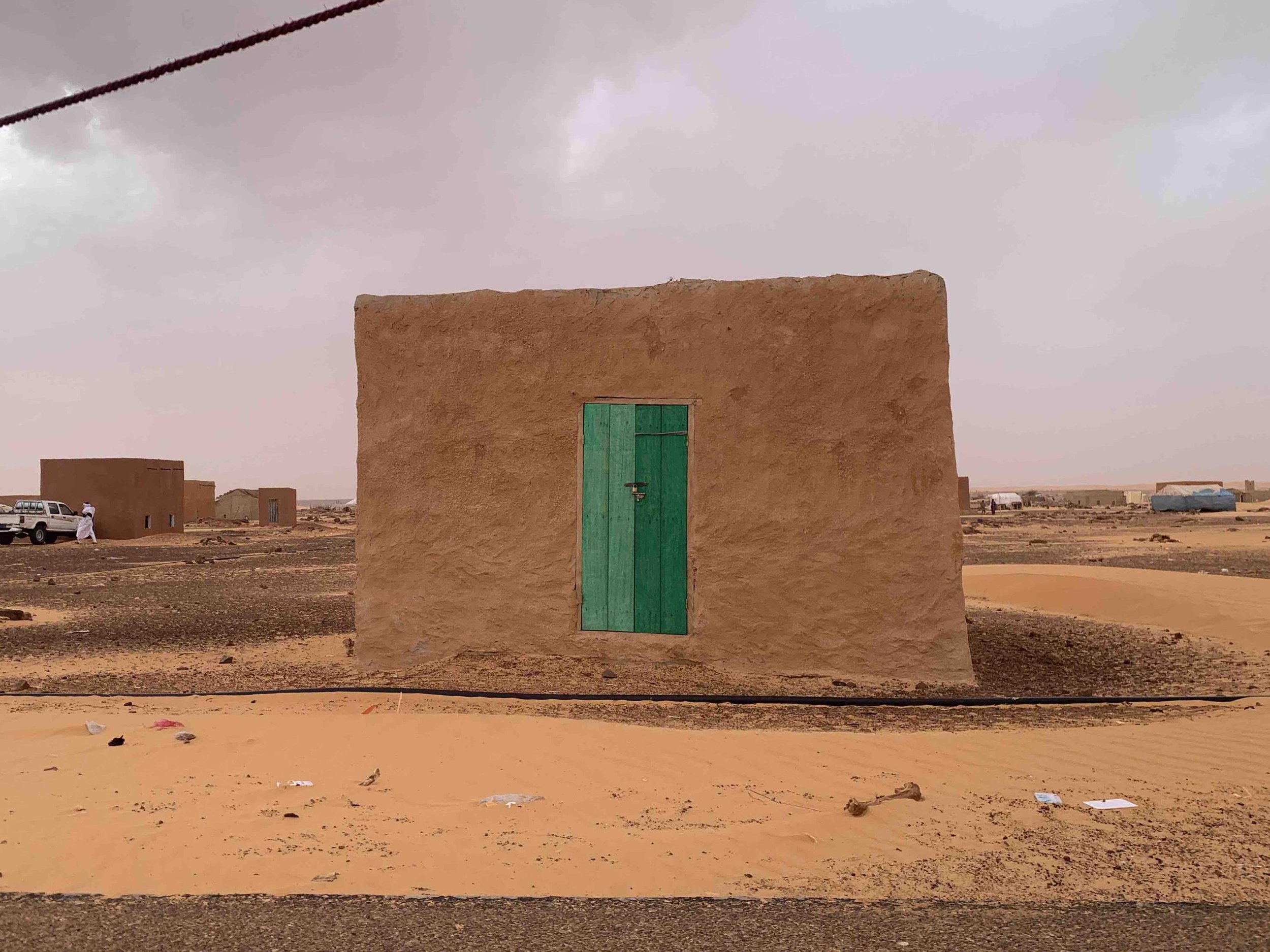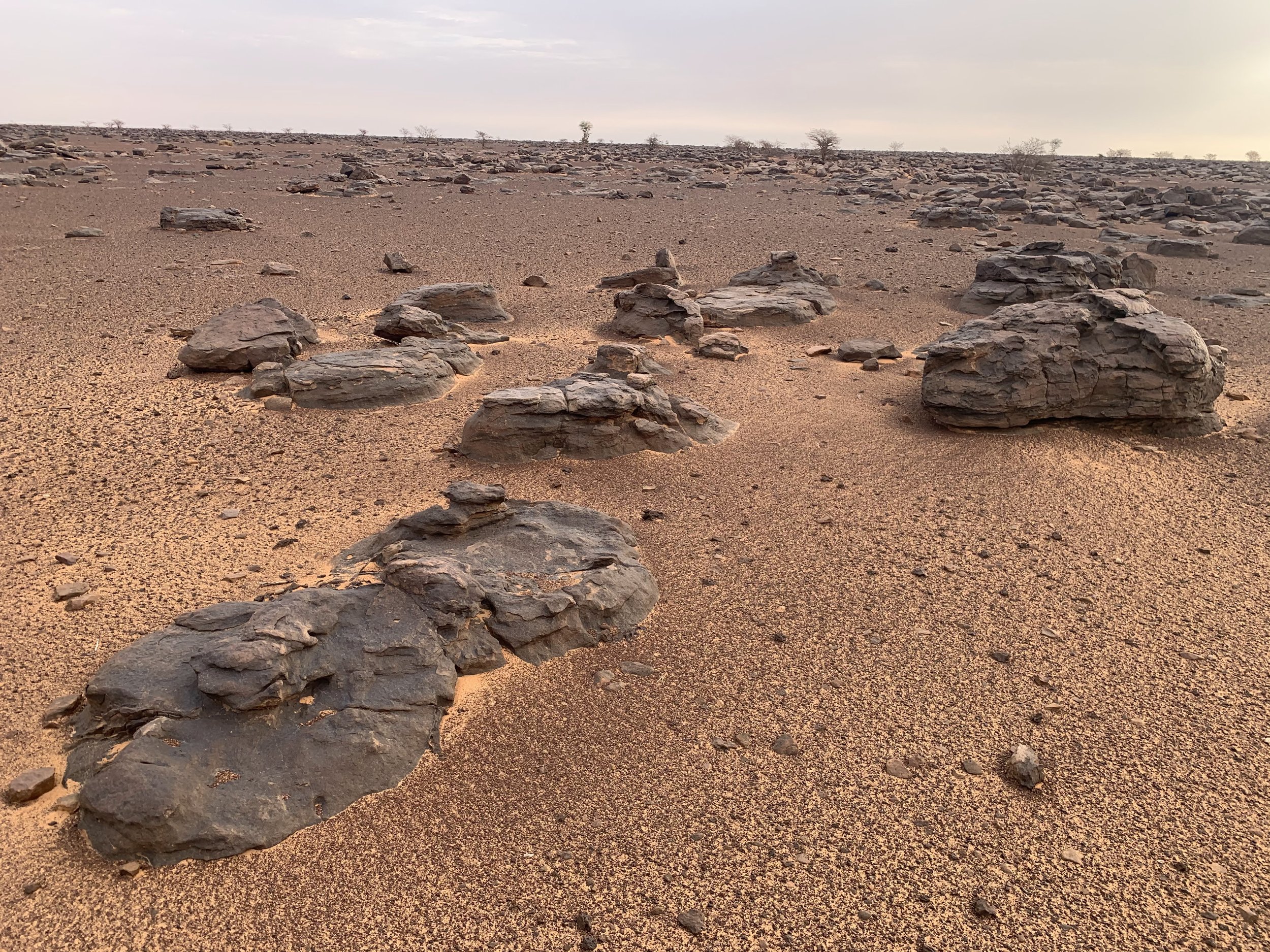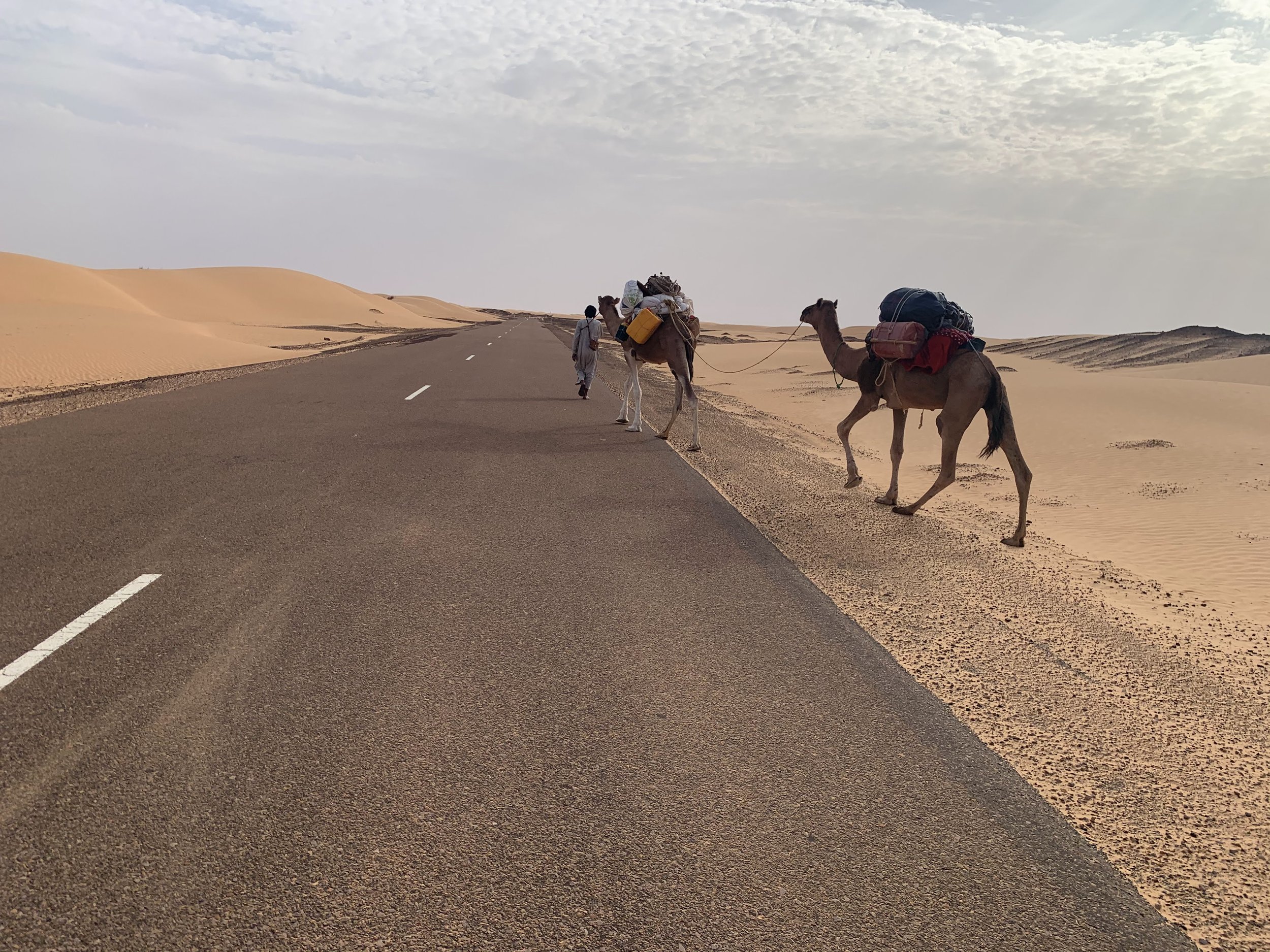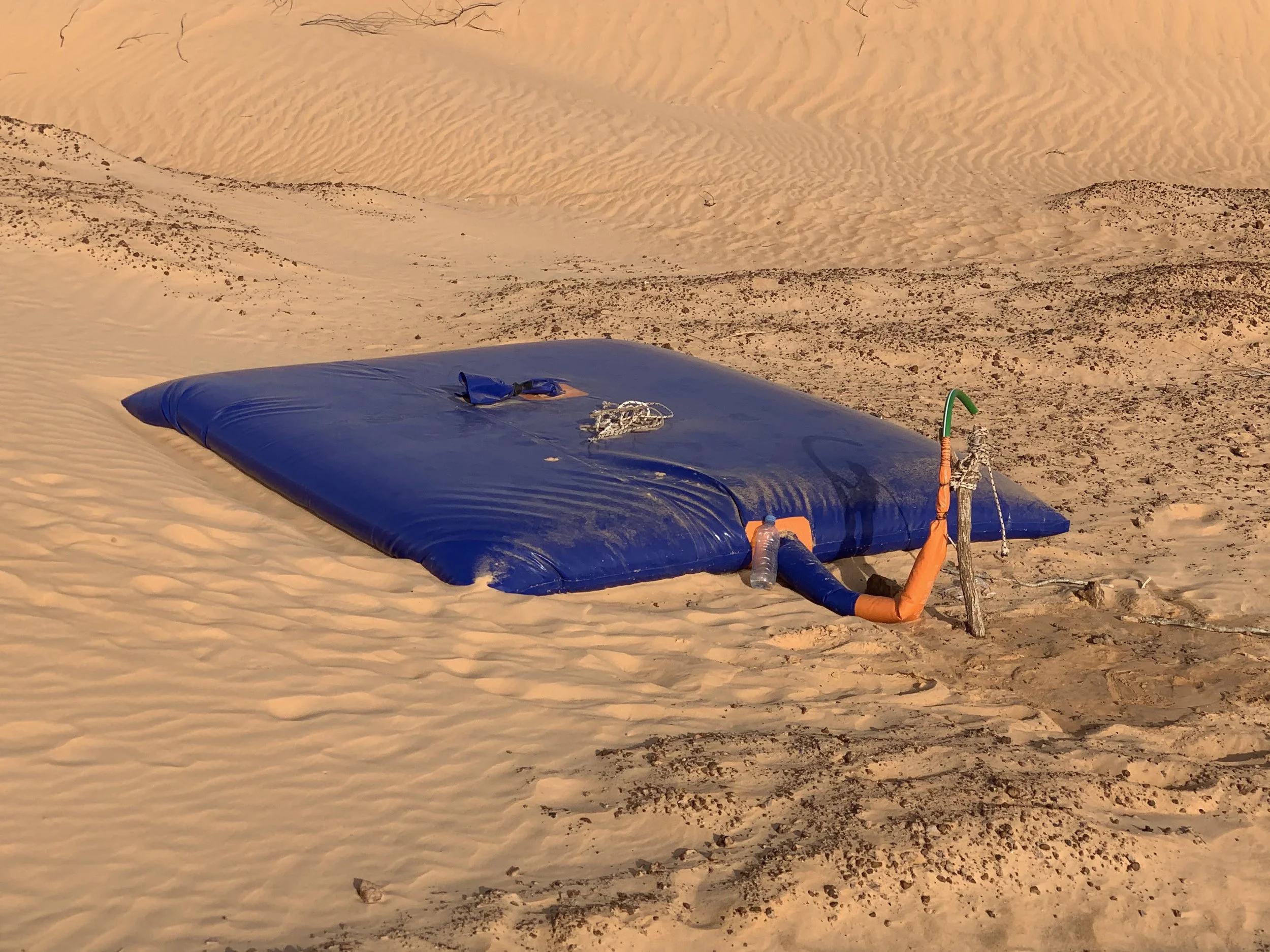qafila khamisa
journal: days 06-08
JOURNAL
3. journal: days 06-08
DAY 06
28.10.2021
4h42 / 19,94 km






Finally a night that I was able to sleep all at once, no wind, no sand, only our camels that at bedtime decided to come and eat at the taichot that protected us.
We realised that more and more the sunrise was delayed, suddenly, I thought we had to change the time next weekend, however, that will not change anything for us, and then, we did not even know what day it was…
The morning tour was nice. Clouds delay the heat and the terrain was basically gravel on sand. We had mountains on both sides, as if it were a feija that prevented the sand from arriving from the east, although on the right we saw the sand accumulated on the mountain, creating dunes on another scale. Some traces of old tracks, talhas, taichots and birds. Sometimes we saw sandstone rocks sculpted by the wind, it reminded me of Fernando Menis' project (in the Sahara). In any case, yesterday it was more obvious that this part of the Adrar was, or could be, a laboratory of sand dynamics, with all possible scales, and in particular thanks to the rocks and hills.
At the end of the feija, and before turning right, we stayed in a small valley, with tall trees and with two wells. The first did not have water, but in the second one, we were able to fill 2 cans. Nefaa thought the water was good, I will see tomorrow if it affects my stomach. Between the two wells, we saw goats and sheeps, probably people who had a small hut between the talhas and taichots.
Then we started to cross small hills of sand and stones and also another family who lived in 2 solid constructions and 2 huts (plus 2 shelters for the animals), surrounded near a set of trees, but always surrounded by sand.
YOU TRY TO ESCAPE THE SAND BUT IT ALWAYS ENDS TO CATCH YOU
It was a talha with branches and without leaves with a very beautiful shape, and obviously surrounded by sand. We thought we were going to be quiet but during the time of preparing lunch the wind was back. I convinced Nefaa to add tomatoes to the pasta and “maarouf” (rice) for a little more flavour. We ate it all; there was another ingredient, the sand. At this point you no longer check whether there is or not.
But the wind picked up speed and Nefaa decided to continue at 14h45, while we were doing it around 16h00. He wanted to stop at "Ain Savra" to buy food for the camels. I thought it would be great to buy food, especially fruit, but the only open store didn't have it. Finally we found some tomatoes, seeds, evaporated milk and mineral water to make some milk in the evening and in the morning.
During the way to the village, we had some rather interesting moments with winds of more than 50 km/h. The sand flowed through the ground with a tone that contrasted with the brown gravel. The result? A white field and a sky of the same color. I thought we were in a nordic region. Just before the village we had to cross a river of sand, which kept inside other spaces. Nefaa even had to look and study where to go with the camels. What a space!
Once in the village, I had the sensation of passing through a camp of refugees, with small stone constructions, huts, tents, sometimes mixed media, stone walls and a structure in wood and straw.
From the village started an asphalt road, the one which goes from Tidjikja to Atar and which is almost finished. I'll take it next week. In the village, 3 people came to meet Nefaa, one was his nephew.
Outside the village we followed the road and we had rain (also during lunch).
To sleep, we looked for a place separated from the road in order to do not hear the cars, but there was no traffic. We improvised a rain protection with the plastic I use to insulate myself from the ground.
DAY 07
29.10.2021
5h28 / 24,44 km






Settling next to a talha shrub has its drawbacks, little thorns everywhere, but if you have sand, even worse, because there will always be a few hidden, no matter how much you clean the area. For this reason I decided not to use the inflatable mattress, too much risk with the thorns, and then since the rain could come at any time, I did not sleep in the bag. With the fog and the moonlight, I thought it was morning but it was only 3h30. Some movements provoked me stings and I couldn't sleep well. I was afraid of having a talha thorn in my foot, I know it hurts a lot and the injury would prevent me from walking.
Later, still in the middle of the night, the rain began to fall. Luckily the protection worked well, although I had to kick the can with one of the ropes attached to it to get the fabric tight. Why with the foot? Getting up involved taking out the lamp, putting on my sandals (out of the question to walk barefoot on a field of thorns). In short, the night was (another) hassle. Doing a qafila without a tent is not wild camping, but wild camping plus, plus. I will have to think of a system to protect ourselves from wind, sand and rain without the need of a tent.
For a while in the morning we were in uninspiring terrain. On Google Maps I thought it was a boulder, but the surface was flat, with medium sized pebbles. We had no visual reference to the horizon, until the dunes appeared. The worst part was 2 hours later, no sign of shade if we ever wanted to rest. Eventually the dunes crossed in our path, but they were isolated and surrounded by rocks. I thought I was in a Japanese garden that used sand instead of gravel, but the effects of wind erosion were very beautiful, putting rocks and sand together.
2h30 and finally a depression appeared in the ground. The talha density increased and according to Nefaa on the next plateau there was shade and a well (borehole). For the first time there was a small navigation problem and we had to correct our direction, from south to south-east.
The borehole (with solar panels and a pump) belongs to someone from Ain Savra. The company that built the road did ground drilling and now they are planting palm trees. On the other hand, there was nobody in this garden, delimited by a fencing spell.
I convinced Nefaa to eat a dish of mine, beans with tomatoes, onions and potatoes. He liked it a lot. I don't know how he does it, but he eats twice as much as I do and he's very thin, but the truth is, he never stops moving.
We did a good part of the afternoon on gravel and then on the road, which allowed us to go faster. On the new road, people were working to try to keep the sand on the edges, with tree branches (not palm trees) but they put it on the ridges of the dunes and it will do nothing. When the road started a small descent, we saw what awaited us tomorrow, and it was scary. First, we had to end the day crossing dunes, some isolated but then we saw smaller, higher and clearer dunes, again as if it were a river or a lake of sand, behind a mountain that we had to bypass to face the last 4 days. On the other hand, Nefaa told me that these dunes, still distant, were not difficult to cross. We will see tomorrow.
30.10.2021
DAY 08
4h47 / 20.09 km






Before finishing our dinner we had a visit, a little mouse from the desert. I had already seen one last night, but it quickly went and hid itself among the shrubs. This time he even entered Nefaa's bowl which was right next to us. The mouse looked like something out of a cartoon, big eyes, high ears, it was so cute. It seems he's always digging for wheat.
I don't know if it's the adaptation to the desert (finally) or the fatigue but I slept very well, despite Nefaa's cough (he doesn't stop smoking) and a few drops of rain.
The day before he had warned me that we were going to have a lot of sand and dunes to cross, in fact, we had to do 4 km between medium dunes. As the 2 first hours in the morning were not hot, it was not very hard. After the dunes, the sand, from a distance it looked without difficulty in terms of topography, but in the end we had to go up and down small ripples all the time.
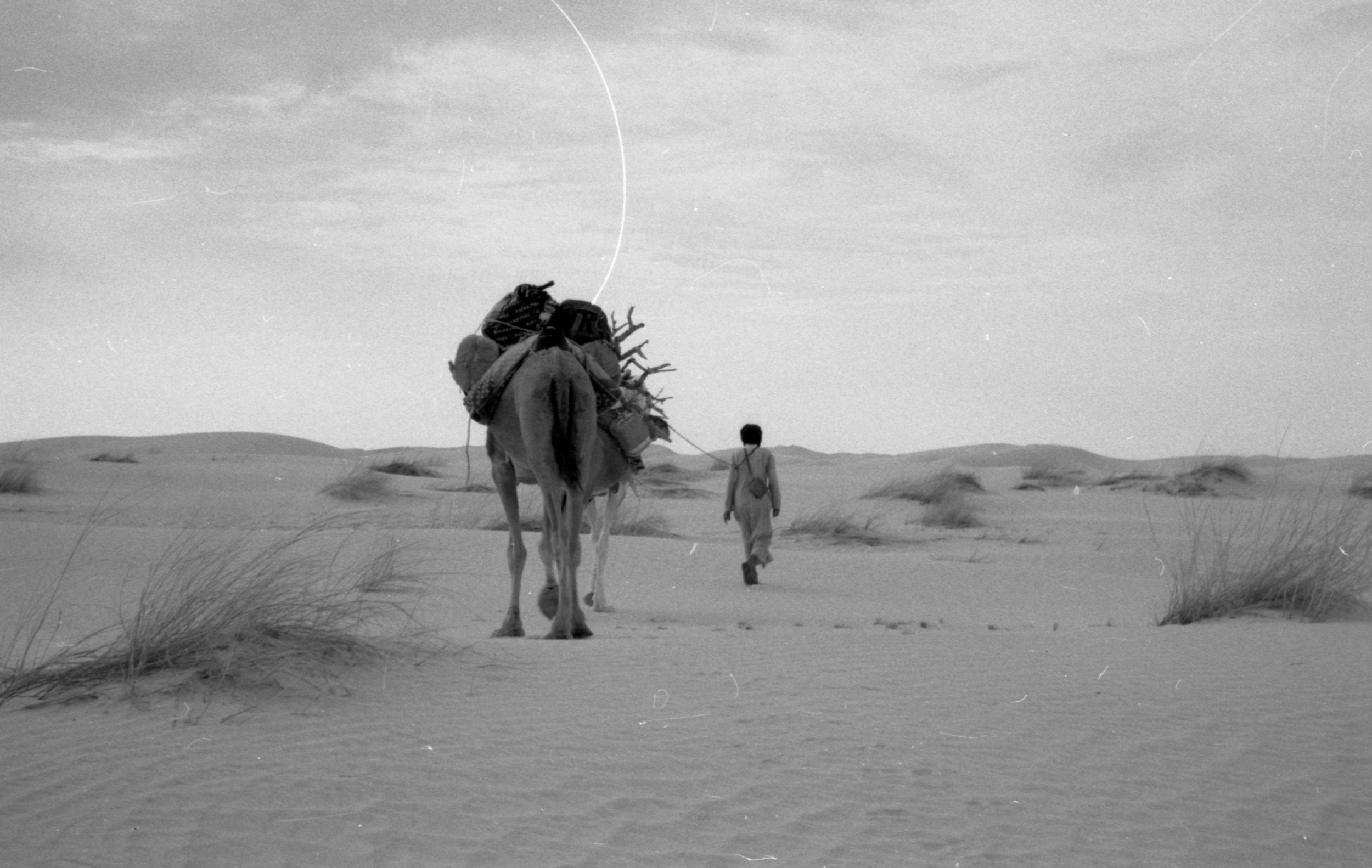


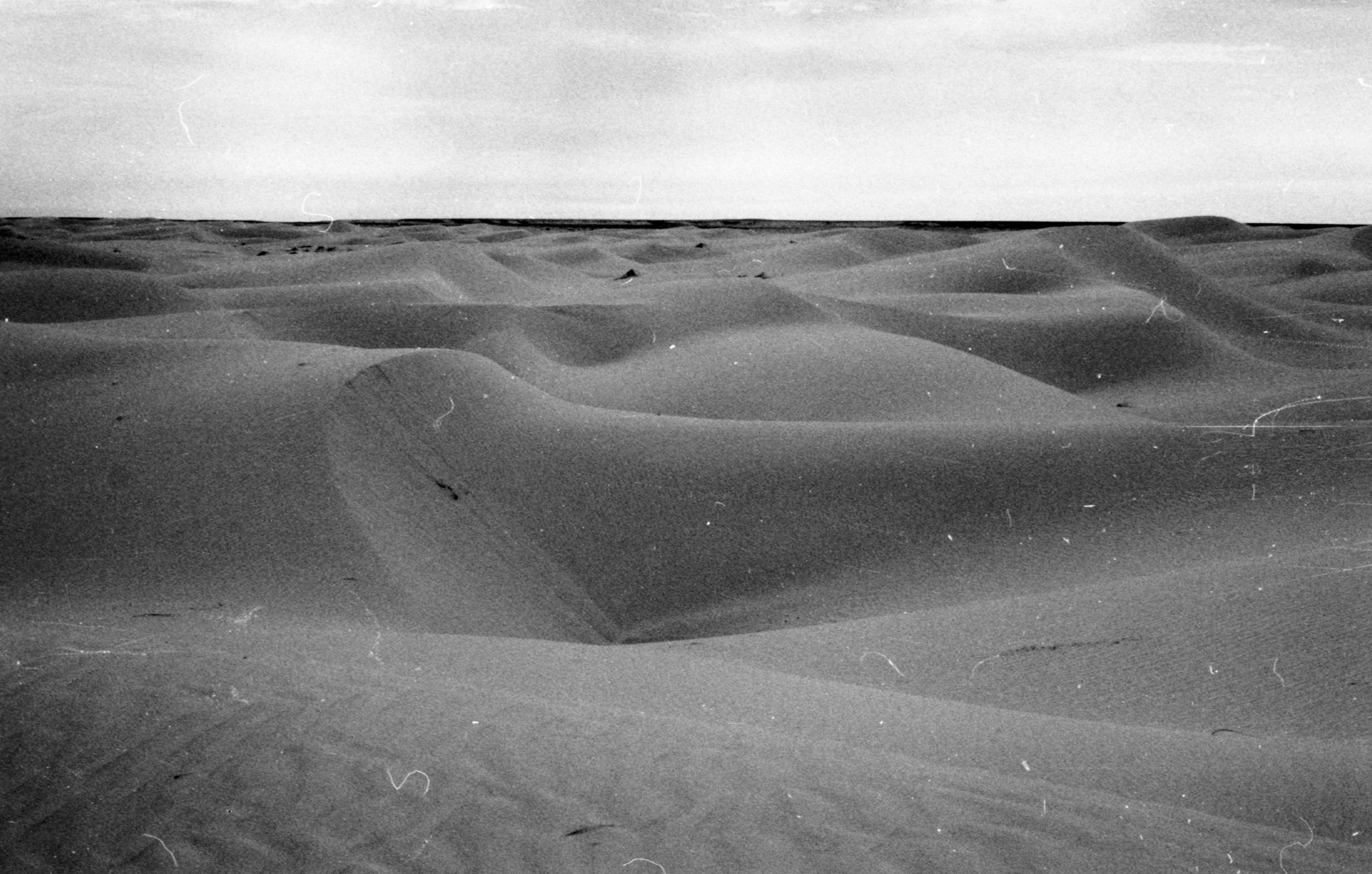
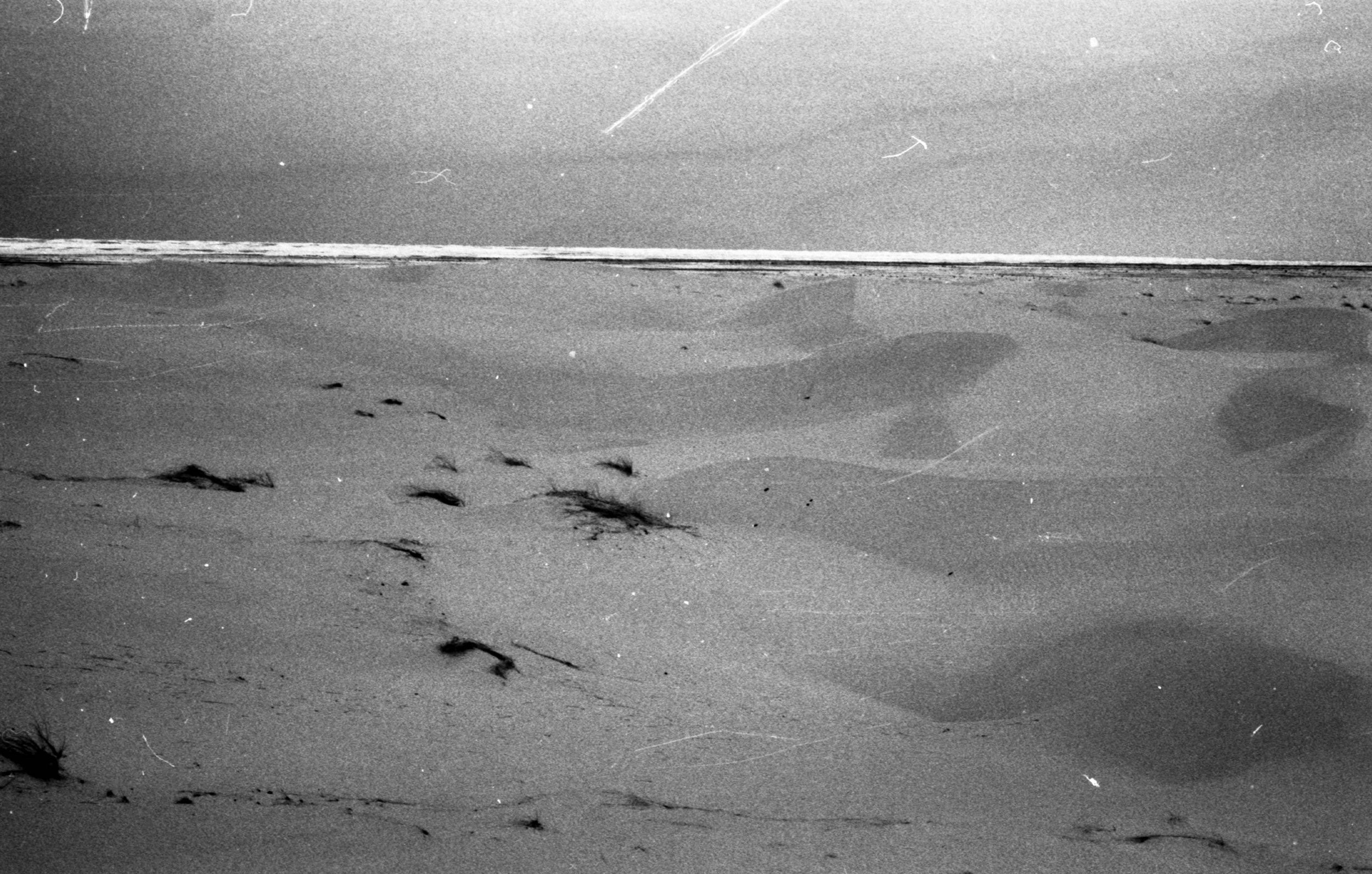
We crossed again the new road but we only saw 5 cars. It is a pity that this one runs parallel to the caravan route, but it is normal that they use the same geography to develop their infrastructures. During Qafila Oula, arriving in Zagora, they had also just finished the road to Tazzarine.
In the morning, Nefaa took a few braces with him because normally we would not find wood during the day, nor talhas for the camels. So, once we got on a small plateau on the dunes, we stopped for 30 minutes, so the camels could eat a type of plant they like. In the meantime, Nefaa didn't waste a second and made some tea (3 glasses for each). Along the way, he also collected some woods he found, but we had already carried enough by the camels. When he chose a place to eat (all of us), I understood, it was to create shade by taking advantage of the fabric I had, which we had used for the rain. He told me he uses the blanket to create shade, but my fabric was lighter and more practical, so I'll have to give it to him as a gift at the end of the trip. In this place, there were quite a few plants growing in the dunes, so the camels were able to eat.
For lunch, Nefaa asked me to make pasta, but I made it with 2 tomatoes and garlic, without the camel meat, it was a pity we didn't have bread...
For the rest of the day, we should arrive at the mountain that tomorrow, bypassing it, will put us in the path to Rachid 2 days later, a small town before Tidjikja. We hope to be able to buy fruit in Rachid and I would like to see how they make the saddles of the camels. According to Nefaa, they can be bought there or in Chinguetti for 3,000 or 4,000 MRU (75-100 €). No, I'm not going to buy one, but when I come back with my car...
After the meal we had, again, visitors, 2 small lizards, sand-colored, very curious and that could run so fast, they seemed as if they were flying on the sand.
We started walking, believing that 9 km later we would arrive at the mountain we had to go around, but the perspective of the landscape did not show what was after the sand, in fact, the undulating ground. was very tiring, we went up and down all the time (between 1.5 and 2 m in height) without seeing the end. After 5km, the end was, more dunes!!
Nefaa explained to me: we will have sand, then a river and then the mountain, but 8km after the rest area we had just finished the dunes. I thought we were going straight to the point of the mountain but we did it perpendicular; we should do it a few more miles, but he's the one who knows the terrain.
It was curious to discover the typical dune plant with which roofs are built here, something similar to straw. The roots come out of the sand and gather in the air. Where do these roots come from, are they extensions of the roots of plants that have already grown? In any case, one could say that they formed art installations.
Credit videos, pictures, texts and drawings: Carlos Perez Marin
Cameras: iPhone XS Max and Leica M6 (Ilford FPE Plus 125)






